Topic: Earth Rotation
Earth Rotation
On June 21, an observer in New York State will see the Sun set
(1) north of due east
(2) north of due west
(3) south of due east
(4) south of due west
A high tide occurred at 6:00 a.m. at a beach on Long Island. The next high tide at this same beach would occur at approximately
(1) 12:15 p.m. on the same day
(2) 6:30 p.m. on the same day
(3) 12:45 p.m. on the following day
(4) 7:00 a.m. on the following day
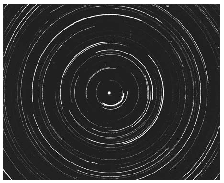
During the time exposure of the photograph, the stars appear to have moved through an arc of 120°. How many hours did this time exposure take?
(1) 5 h
(2) 8 h
(3) 12 h
(4) 15 h
What causes many surface winds to deflect to the right in the Northern Hemisphere?
(1) rotation of Earth on its axis
(2) unequal heating of Earth’s surface
(3) gravitational force of the Moon
(4) gravitational force of the Sun
An observer on Earth measures the angle of sight between Venus and the setting Sun.

Which statement best describes and explains the apparent motion of Venus over the next few hours?
(1) Venus will set 1 hour after the Sun because Earth rotates at 45° per hour.
(2) Venus will set 2 hours after the Sun because Venus orbits Earth faster than the Sun orbits Earth.
(3) Venus will set 3 hours after the Sun because Earth rotates at 15° per hour.
(4) Venus will set 4 hours after the Sun because Venus orbits Earth slower than the Sun orbits Earth.
At a location in the Northern Hemisphere, a camera was placed outside at night with the lens pointing straight up. The shutter was left open for four hours, resulting in the star trails shown below.

At which latitude were these star trails observed?
(1) 1° N
(2) 30° N
(3) 60° N
(4) 90° N
The map below shows a portion of Earth’s system of latitude and longitude and five surface locations labeled A, B, C, D, and X.
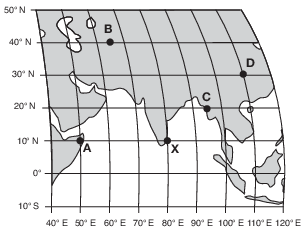
It is solar noon at location X. At which location will solar noon next occur?
(1) A
(2) B
(3) C
(4) D
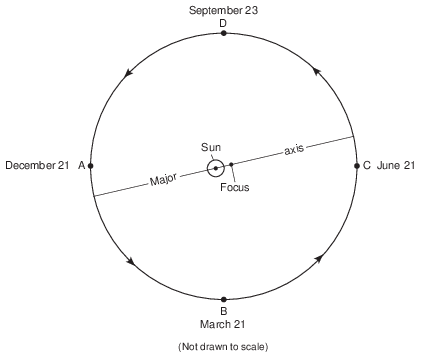
At which two positions will an observer in New York State experience approximately 12 hours of daylight during one rotation of Earth?
(1) A and B
(2) A and C
(3) B and C
(4) B and D
When it is solar noon at a location at 75° W longitude, what is the solar time at a location at 120° W longitude?
(1) 9 a.m.
(2) 12 noon
(3) 3 p.m.
(4) 12 midnight
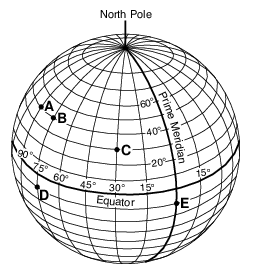
Which two locations have the same solar time?
(1) A and B
(2) B and D
(3) C and E
(4) D and E
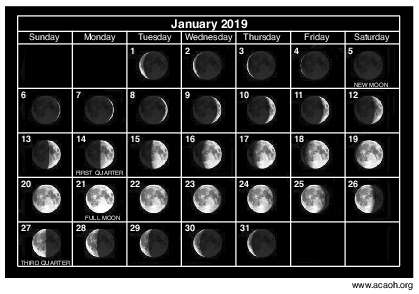
On the diagram in the image provided, place an X on each of the two positions of the Moon in its orbit where neap tides (the smallest difference in the water levels between high tide and low tide) occur. [1]
Allow 1 credit if the centers of only two Xs are placed on the diagram – one to indicate the 1st quarter phase and one to indicate the 3rd quarter phase, as shown below.
• 
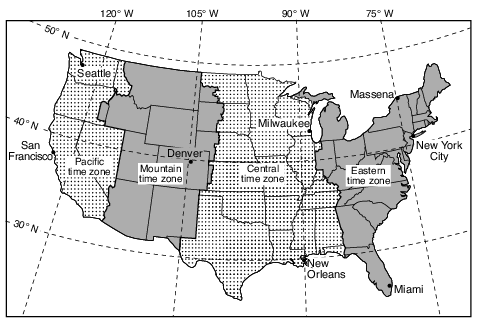
State the time at San Francisco, California, when it is 12 noon at New Orleans, Louisiana. Indicate a.m. or p.m. in your answer. [1]
Allow 1 credit. Acceptable responses include, but are not limited to:
• — 10:00 a.m.
• — 10 am
• — 1000 (military time)
• — 10 in the morning
The Sun travels 45° in its apparent path between the noon position and point A. Identify the time when the Sun is at point A. Include a.m. or p.m. with your answer. [1]
Allow 1 credit for 3 p.m. or 3:00 p.m.
• Note: Allow credit if the “p.m.” lacks periods.

Predict the length of the object’s shadow at 2:30 p.m. [1]
cm
Allow 1 credit for any value from 130 cm to 160 cm.
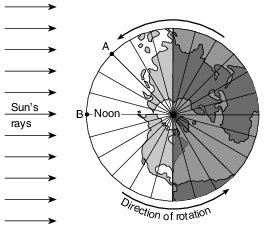
State the time at location A when it is noon at location B. Indicate a.m. or p.m. in your answer. [1]
Allow 1 credit for a response that indicates a time value of 9 a.m. Acceptable responses include, but are not limited to:
• — 9:00 a.m.
• — 9 o’clock in the morning
• — 0900
